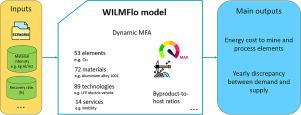2100年前金属开采和加工能耗及潜在金属供需失配评价
IF 10.9
1区 环境科学与生态学
Q1 ENGINEERING, ENVIRONMENTAL
引用次数: 0
摘要
金属对全球能源转型至关重要。为了在全球经济中使用这些金属,提取和加工这些金属都需要能源。考虑到本世纪末之前对金属的需求将不断飙升,目前尚不清楚各生产国的采矿和冶金行业是否能够应对这种供应压力。我们估计了50种资源在三种社会演变情景下的年盈余和赤字,以及开采和加工这些资源的全球能源消耗。方法:我们开发了极限金属流动(WILMFlo)模型,这是一个库存驱动的动态材料流分析资源的生命周期。WILMFlo将铜等主要金属的提取与碲等副产品的提取联系起来,使用副产品与母体的比率。通过考虑年采矿能力,它可以确定2025年至2100年三种社会经济情景下的潜在供需差异,包括净零情景。我们还探讨了全球范围内采矿资源和材料制造的能源消耗演变。结果:首先,我们量化了资源供需之间的潜在差异,包括年度盈余和赤字。其次,推导出2025年至2100年全球金属开采和加工能源成本。在净零情景中,我们确定了2028年至2038年之间锂的潜在赤字。在这三种情况下,目前分类的关键元素,如铟、铼或镓,在21世纪处于供过于求的局面。讨论和结论:替代一些能源过渡金属,如铜、钴和锂,将是满足全球对移动性和储能需求的关键。在21世纪,全球采矿能源消耗可能会上升,但与材料加工能源消耗相比仍然很小,后者是全球采矿能源消耗的2至6倍。WILMFlo框架可以加深对能源过渡金属潜在供应限制的理解,并确定提高初级供应链能源效率的最大潜力。本文章由计算机程序翻译,如有差异,请以英文原文为准。

Evaluation of metals mining and processing energy consumption and potential metals supply–demand mismatch towards 2100
Introduction:
Metals are essential for the global energy transition. Energy is required to both extract and process those metals to use them in the global economy. Given the soaring demand for metals until the end of the century, it is unclear whether the mining and metallurgical industry across producing countries will be able to cope with such pressure on supply. We estimate the yearly surplus and deficit of 50 resources across three scenarios of evolution of society as well as global energy consumption for mining and processing those resources.
Methods:
We develop the Within Limits Metal Flows (WILMFlo) model which is a stock-driven dynamic material flow analysis of resources over their life cycle. WILMFlo links the extraction of major metals, such as copper, to their byproducts, such as tellurium, using byproduct-to-host ratios. By considering yearly mining capacity, it allows to identify potential discrepancies between demand and supply between 2025 today to 2100 in three socioeconomic scenarios, including a Net Zero scenario. We also explore the evolution of energy consumption for mining resources and for materials fabrication at the global level.
Results:
First, we quantify the potential discrepancies between demand and supply of resources, including yearly surplus and deficit. Second, we derive the global metal mining and processing energy cost between 2025 and 2100. In the Net Zero scenario, we identify a potential deficit of lithium between 2028 and 2038. In the three scenarios, currently classified critical elements such as indium, rhenium or gallium are in situation of oversupply over the 21st century.
Discussions and conclusions:
The substitution of some energy transition metals such as copper, cobalt and lithium will be key to meet the global demand for mobility and energy storage. Global mining energy consumption is likely to rise during the 21st century but will still remain minor compared to materials processing energy consumption which is two to six times higher than global mining energy consumption. The WILMFlo framework allows to deepen the understanding of energy transition metals potential supply limits and to identify the greatest potential to improve energy efficiency on the primary supply chain.
求助全文
通过发布文献求助,成功后即可免费获取论文全文。
去求助
来源期刊

Resources Conservation and Recycling
环境科学-工程:环境
CiteScore
22.90
自引率
6.10%
发文量
625
审稿时长
23 days
期刊介绍:
The journal Resources, Conservation & Recycling welcomes contributions from research, which consider sustainable management and conservation of resources. The journal prioritizes understanding the transformation processes crucial for transitioning toward more sustainable production and consumption systems. It highlights technological, economic, institutional, and policy aspects related to specific resource management practices such as conservation, recycling, and resource substitution, as well as broader strategies like improving resource productivity and restructuring production and consumption patterns.
Contributions may address regional, national, or international scales and can range from individual resources or technologies to entire sectors or systems. Authors are encouraged to explore scientific and methodological issues alongside practical, environmental, and economic implications. However, manuscripts focusing solely on laboratory experiments without discussing their broader implications will not be considered for publication in the journal.
 求助内容:
求助内容: 应助结果提醒方式:
应助结果提醒方式:


